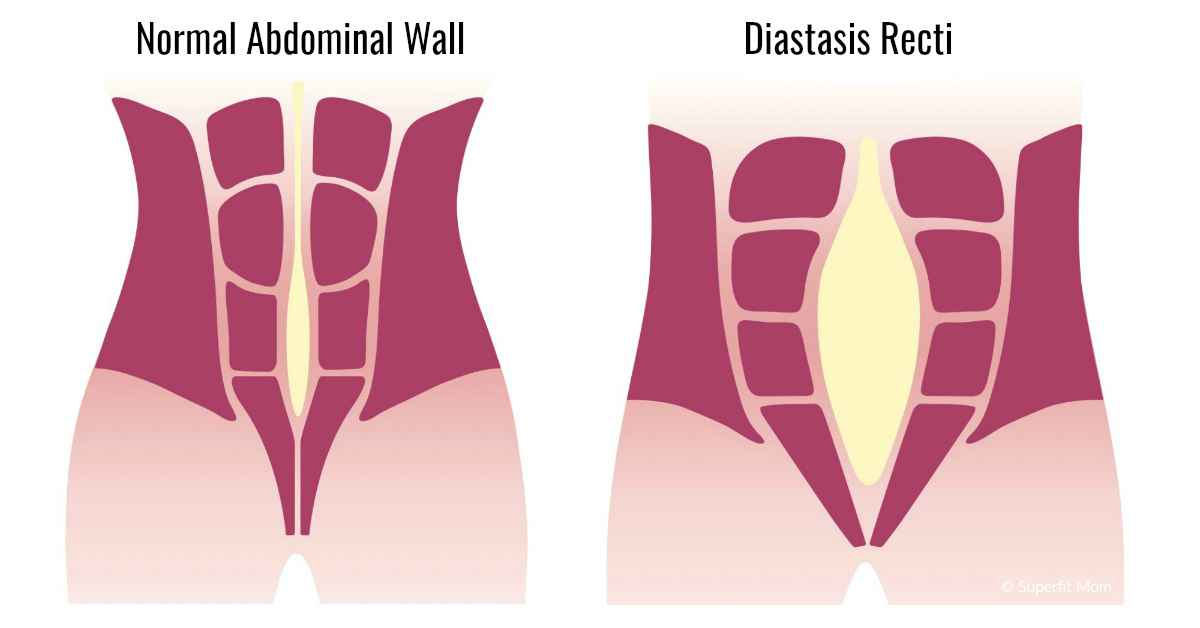Diastasis Recti: Here's what you need to know
Still look pregnant even though you are not! Perhaps you have abdominal separation or Diastasis Recti.
Read on and get important information on this common (but not normal!) condition ...

A separation of the abdominal muscles is also known as diastasis of the rectus abdominis or simply Diastasis Recti (DR). The terms refer to the separation (diastasis) of the right and left side of the vertical abdominal muscles (rectus abdominis i.e. the six pack muscles).
If you have a gap between the abdominal muscles (an inter-rectus distance) larger than the width of 2 fingers, you have Diastasis Recti. Keep in mind that this is a general guideline.
There are several other important factors than the inter-rectus distance that need to taken into consideration when determining if you have DR. Keep reading and you'll know much more.
Diastasis Recti occurs as a result of increased intra-abdominal pressure (usually because of pregnancy) on the linea alba, the band of connective tissue that divides the abdominal muscles down the middle.
The excessive pressure stretches this connective tissue and makes it thinner and weaker – which causes the Diastasis Recti.
The consequences of abdominal separation are numerous:
- Functional consequences – Reduced stability, support, and protection of the core.
- Aesthetic consequences – a "pooch", "mummy tummy", "baby belly " – and similar less than flattering terms!
Why do I still look pregnant?
Aesthetically, an increased inter-rectus distance will usually cause the belly to bulge or dome. This is not to be mixed up an increased bulging caused by fatty tissue that may cover the abdominal muscles.
Typical symptoms of a Diastasis Recti:
- Your belly bulges especially around the belly button area.
- You look pregnant even though you no longer are pregnancy.
- The belly feels soft and flabby.
- The upper part of the abdomen may also bulge more than before. This is often caused by a Diastasis Recti extending all the way from the pubic bone to the breastbone.
How Diastasis Recti Affects the Way your Body Works
A Diastasis Recti is not a dangerous condition in and of itself; rather it is normal for the abdominal muscles to separate to a larger or smaller degree during pregnancy.
In fact: 100 % of all pregnant women develop a Diastasis Recti during their third trimester!
The increased inter-rectus distance is nature's way of making room for a growing foetus behind your abdominal muscles.
However, a Diastasis Recti may cause an array of problems such as:
-
Lower Back Pain
-
Pelvic pain/Pelvic instability
-
Incontinence
-
Pelvic Organ Prolapse
-
Hernia
-
Constipation
-
Bad posture
Understanding Diastasis Recti
The rectus abdominis consist of two parallel muscles bodies that extends the length of the anterior abdominal wall. The muscles are separated by a band of connective tissue called linea alba, "white line".
Bonus info: The rectus abdominis are also known as the "sixpack muscle" muscles that can be observed in very fit individuals with low body fat ... you know, the washboard abs.
The linea alba is a thick structure of elastic fibres. During pregnancy the hormone relaxin makes it easier for the linea alba to stretch and widen.
When the connective tissue is stretched horisontally, it becomes thinner, covering the internal organs like a layer of "cling film".
The result is a larger gap between the two sides of the abdominal muscles that now run down the anterior wall further to each side of the abdomen, almost like trouser suspenders.
When the connective tissue of the linea alba has been stretched and thinned, it no longer offers the necessary support and stability to the abdominal wall and the core.
All four groups of abdominal muscles (the rectus abdominis, the transversus abdominis and the external and internal oblique muscles) are connected to the linea alba. As a result, all abdominal muscles are affected when a Diastasis Recti occurs.
Poor posture puts constant strain on the connective tissue, thereby contributing to the occurrence (and "maintenance" of a Diastasis Recti. This is the case both during and after pregnancy.
Read more below under: "How do I fix my Diastasis Recti?".
Can a Diastasis Recti correct itself?
During the first couple of weeks after giving birth your body will do a lot of healing on its own, and in many women the separation of the abdominal muscles will, to some degree, correct itself.
However most women find that the spontaneous recovery, i.e. the narrowing of the gap, stagnates approx. 6-10 weeks postpartum.
In fact, research shows that if you do not actively help your body close the gap, your Diastasis Recti will remain the same size after one year as it was 8 weeks postpartum.
This means that a Diastasis Recti – and its functional and aesthetic consequences – can persist years after giving birth and, possibly, for the rest of your life.
How do I know if I have Diastasis Recti?
The condition often reveals itself during pregnancy when the belly shows a vertical doming shape (much like a Toblerone chocolate) when you tense your stomach muscles, especially when lying down.
A "Toblerone belly" postpartum is a sure sign that you still have Diastasis Recti.
Separated abdominal muscles affect the function of the entire body.
The symptoms of Diastasis Recti are problems in your lower back/middle back/shoulders and a sense of core instability or inability to engage your core.
Research shows that 66 % of women with Diastasis Recti also display at least one functional pelvic floor problem, such as incontinence (leaking urine when sneezing or jumping) or uterine prolapse.
Who gets Diastasis Recti?
All pregnant women develop some degree of abdominal separation by the third trimester.
The good news is that there is a lot you can do yourself to keep the separation at an absolute minimum and make sure the separation does not cause problems both during and after pregnancy.
The Diastasis Recti will most often occur during the second or third trimester. But if you have been pregnant more than once and/or if you are expecting twins or triplets, it is not unusual to see the abdominal seperation showing up already in the first trimester.
The risk of developing Diastasis Recti increases with:
- Multiple pregnancies
- Multiparity
- Weak/untrained core muscle
- Have poor posture
Diastasis Recti is most common among women who have been through pregnancy because of the massive stretch of the abdominal wall during pregnancy combined with the hormonal effects of pregnancy. But the condition is also seen in children, men, and women who have not had children.
Width, depth and tension are all important
It is not only the width of a Diastasis Recti that is crucial. So is the depth of the gap and the ability of the connective tissue to transfer load (i.e. to tense up when the core is engaged).
The linea alba should tense when you engage your abdominals. So, when measuring your Diastasis Recti, observe both width, depth, and tension.
For women who have had children the aim is to reduce the gap to a width of 1-1,5 fingers. This however, should be seen as a general guiding line.
Not all women will be able to reduce the gap to 1-1,5 fingers, but may still achieve a fully functioning core and a flat belly, even with a (shallow, firm) gap of perhaps 2-3 finger widths. This is known as a functional Diastasis Recti.

Test yourself for Diastasis Recti
Check yourself for Diastasis Recti/abdominal separation:
- Lie on your back with your knees bent and your feet on the floor.
- With the fingers pointing down, place the fingertips of one hand at the center of your stomach a few centimeters above the belly button.
Lightly press the fingers into your stomach and lift your head (not your shoulders) slowly from the floor.
Abdominal separation is typically measured in finger width.
Anything above two fingers is considered to be a Diastasis Recti. In severe cases the gap may be as large as the width of 8-12 fingers.
